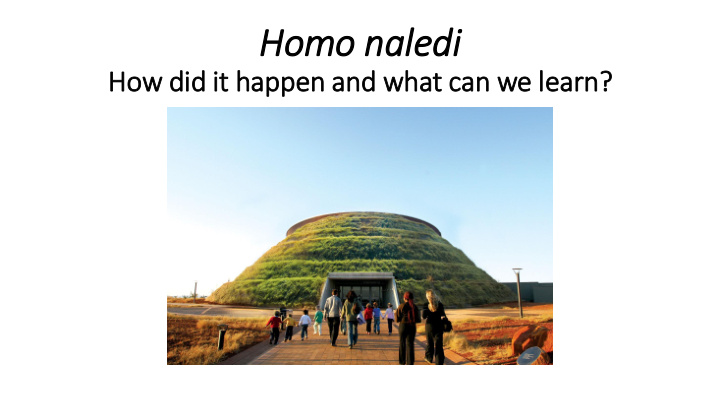



Homo naledi How did id it it happen and what can we le learn?
SIG IGNIFICANCE • Cradle of Humankind area is 53 ha of privately owned land in the west of Gauteng. • ALL of the land is privately owned. Sterkfontein is owned by Wits • Declared a World Heritage Site in 1999 • By far the vast majority of the world’s Hominin fossil finds have been found in this site (before H. naledi , over 800 fossils)
Vision
VISION • Area was one of the poorest areas in Gauteng • Started with some 47 tourism operations • Now has over 400 • Significant tourism growth in the tourism and leisure sectors since listing. • Inception planning involved visits to Lascaux in France and Dynamic Earth in the UK • Sterkfontein as a natural resource can only manage 800 per day • Design was to be multi-purpose, multi-functional and not in competition with surrounding tourism ventures.
Vision
VISION • Sterkfontein was to be a modest building, with a strictly scientific exhibition • Maropeng, 10 kms away (and off the World Heritage Site), would be an iconic building with an underground experience aimed at as broad a range of tourist as possible. Exhibition was intended to be as interactive as possible aimed at a broad audience. • Maropeng would take in all of Human development, from our earliest beginnings - to our expolitative present – to our uncertain future.
VISION
VISION • Government provided R360m for the upgrade of the area. • This included 36 kms of roads and bulk infrastructure • Connectivity with Lanseria airport, Magaliesburg and the North West Province. • An iconic Tumulus building at Maropeng • Underground experience • Boatride • Contemplative space for viewing original fossils • Virtual Laboratory • Centrepiece for the World Heritage Site as a whole. • 24 bed boutique Hotel. • 120 bed multi- use “learners” accommodation • Intended that it would take 20 years to attain self-sufficiency.
HOMO NALEDI
HOMO NALEDI • Previously unknown species, clearly bipedal and connected in some way to the human genetic path • Required extremely small scientists to do the excavation • Over 1 800 bones found in 1 square metre of excavation. • Extremely unusual, fragile bones. • All of one species, with specimens from babies to old age • Only other species was a relatively recent owl and its dinner. • Upper body ape-like • Lower body modern human • Brain the size of an orange
HOMO NALEDI
HOMO NALEDI • Professor Lee Berger discovered not only H. sediba in 2010, but now also H. naledi. • As he put it in 2010 “This is so off the charts, it makes winning the lottery look easy”. (I would want to add – twice!) • H. naledi had all the elements of an intriguing mystery. So many bones; all of the same species; in a cave with highly restricted entry. • National Geographic quickly took hold of the story and it became international news. • H. naledi became, over a period of three weeks, as famous a brand as that other immediately recognisable South African name, “Nelson Mandela”.
HOMO NALEDI • With H. naledi there were a number of interlinked stories that captivated the public imagination: • The story of the find itself; • The story of the “Underground astronauts”; • The story of the possible burial ground. • Visitor numbers sky-rocketed. From the usual 300 visitors a day, we were getting 3 500 people per day. • Visitors across race, gender, age, religion, Province and country.
HOMO NALEDI 160000 30000 140000 25000 120000 20000 100000 15000 Maropeng 80000 Sterkfontein 10000 60000 40000 5000 20000 0 Sept Oct 2013 Sept Oct 2015 Sept Oct 2015 0 2013 2014 2015 Total 2013 Total 2014 Total 2015
HOMO NALEDI • Plans are afoot to have a permanent exhibition of H. naledi at Maropeng • Presently installing temporary exhibition space for specific themed exhibitions • Also long-term exhibitions for the latest finds
THE LONG AND THE SHORT OF THE STORY The STORY is what sells The STORY is what compels The STORY is what gets re-told
Recommend
More recommend